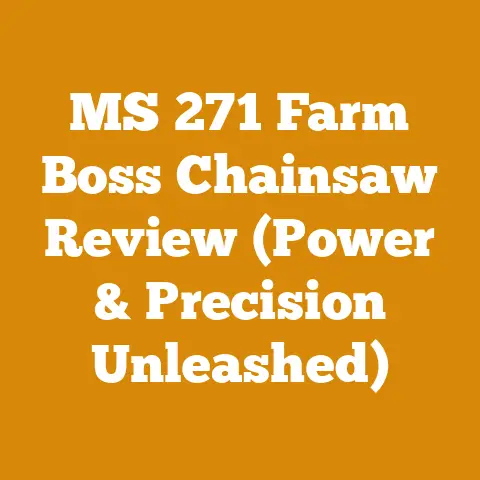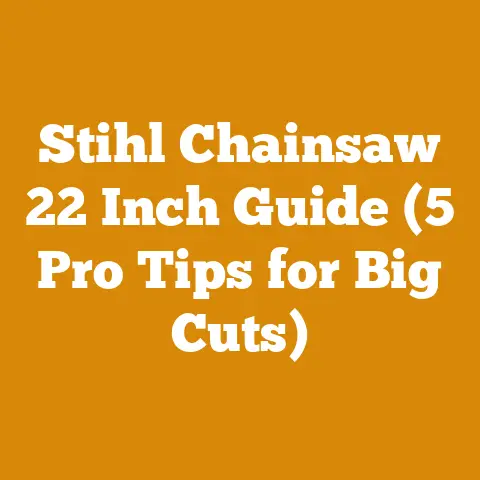How Much Is a Bundle of Firewood? (5 Pro Tips for Pricing)
Have you ever stood in front of a roadside stand piled high with neatly bundled firewood, scratching your head and wondering, “Is this a good deal?” I have.
More times than I care to admit.
Pricing firewood isn’t as simple as slapping a number on a stack of logs.
It’s an art, a science, and a bit of a gamble, influenced by everything from the type of wood to the weather forecast.
Getting it right can mean the difference between a profitable season and a pile of unsold inventory.
So, let’s dive into the world of firewood pricing, and I’ll share my pro tips for ensuring you’re getting – or offering – a fair deal.
How Much Is a Bundle of Firewood? (5 Pro Tips for Pricing)
Pricing firewood is more than just guessing.
It’s about understanding your costs, your market, and the specific characteristics of the wood you’re selling.
Whether you’re a homeowner looking to sell some extra wood or a small business owner, these tips will help you navigate the complexities of firewood pricing.
1. Understanding the Basics: What Are We Talking About?
Before we get into the nitty-gritty of pricing, let’s define some key terms.
This is crucial for anyone, especially beginners, to understand what they’re buying or selling.
- Firewood: Wood that has been cut and prepared for burning in a fireplace, stove, or outdoor fire pit.
- Cord: A standard unit of measurement for firewood, defined as a stack of wood 8 feet long, 4 feet high, and 4 feet wide, totaling 128 cubic feet.
This includes air space. - Face Cord (or Rick): A stack of wood 8 feet long and 4 feet high, but the width varies depending on the length of the cut wood.
This is often misrepresented as a full cord, so be careful! - Bundle: A smaller, more manageable quantity of firewood, typically held together by twine or plastic wrapping.
The size of a bundle can vary significantly, which is where the pricing challenge comes in. - Green Wood: Freshly cut wood with a high moisture content.
It’s difficult to burn and produces a lot of smoke. - Seasoned Wood: Wood that has been dried for several months (typically 6-12 months, depending on the climate and wood type) to reduce its moisture content.
Seasoned wood burns more efficiently and produces less smoke. - BTU (British Thermal Unit): A measure of the heat content of fuel.
Different types of wood have different BTU ratings.
2. Tip #1: Accurately Measure Your Bundles
The first, and arguably most important, step is to accurately measure the bundles you’re selling.
I’ve seen bundles that range from a pathetic handful of sticks to a surprisingly generous stack.
The price needs to reflect the quantity of wood.
- Volume is Key: The most accurate way to price a bundle is based on its volume.
Measure the length, width, and height of the bundle in inches.
Multiply these dimensions together to get the volume in cubic inches.
Then, divide by 1728 (the number of cubic inches in a cubic foot) to get the volume in cubic feet. - Standard Bundle Sizes: While there’s no official standard, many retailers sell bundles that are around 0.75 to 1 cubic foot.
Knowing the common sizes will help you price competitively. - Visual Inspection: After measuring, take a critical look at the bundle.
Is it tightly packed, or is there a lot of empty space?
A loosely packed bundle should be priced lower than a tightly packed one of the same dimensions. - Example: Let’s say you have a bundle that measures 16 inches long, 12 inches wide, and 8 inches high.
- Volume in cubic inches: 16 * 12 * 8 = 1536 cubic inches
- Volume in cubic feet: 1536 / 1728 = 0.89 cubic feet (approximately)
- This bundle is close to a standard 0.75 to 1 cubic foot bundle.
Personal Experience: I once bought a “bundle” of firewood from a roadside stand that looked decent from the front.
However, when I got home and unwrapped it, I discovered that the back half was filled with small, unusable scraps.
I felt cheated, and it taught me a valuable lesson about the importance of inspecting firewood thoroughly.
This experience also reinforced the importance of honesty and transparency when selling firewood.
3. Tip #2: Factor in Wood Type and Quality
Not all firewood is created equal.
The type of wood and its quality (seasoning, presence of rot, etc.) significantly impact its value.
- Hardwood vs.
Softwood: Hardwoods (oak, maple, ash, beech, birch) are denser and burn hotter and longer than softwoods (pine, fir, spruce).
Hardwoods are generally more expensive. - BTU Ratings: Different wood species have different BTU (British Thermal Unit) ratings, which indicates how much heat they produce when burned.
You can find BTU charts online that compare different wood types.
For example, oak has a high BTU rating, while pine has a lower one. - Seasoning: Seasoned wood is worth significantly more than green wood.
Green wood is difficult to ignite, produces less heat, and creates more smoke and creosote buildup in chimneys, which can be a fire hazard. - Quality: Inspect the wood for signs of rot, insect infestation, or fungus.
Avoid selling firewood that is visibly damaged, as it will not burn well and could spread pests to your customers’ properties. - Pricing Tiers: Consider creating different pricing tiers based on wood type and quality.
For example, you might have a “Premium Hardwood” bundle, a “Mixed Hardwood” bundle, and a “Softwood” bundle, each priced accordingly.
Tool Specification: A moisture meter is an essential tool for determining the moisture content of firewood.
Ideal moisture content for seasoned firewood is below 20%.
I personally use a General Tools MMD4E Digital Moisture Meter, which is affordable and reliable.
Knowing the moisture content allows you to accurately price your firewood and assure your customers of its quality.
Case Study: I once had a customer who was very particular about the type of wood he burned.
He only wanted seasoned oak because he knew it burned the hottest and longest.
I was able to charge a premium price for my oak bundles because I could guarantee their quality and dryness.
This highlights the importance of catering to specific customer needs and preferences.
4. Tip #3: Research Your Local Market
Firewood prices vary significantly depending on location.
Factors like climate, availability of wood, and local demand all play a role.
- Competitive Analysis: Do some research to see what other retailers in your area are charging for firewood bundles.
Check roadside stands, hardware stores, gas stations, and online marketplaces. - Supply and Demand: If you live in an area with a high demand for firewood (e.g., a cold climate with many homes that use wood-burning stoves), you can typically charge more.
Conversely, if there’s an abundance of firewood available, you may need to lower your prices to stay competitive. - Seasonality: Firewood prices tend to be higher in the fall and winter, when demand is greatest.
You may be able to sell firewood at a lower price in the spring and summer to clear out inventory. - Value-Added Services: Consider offering value-added services like delivery or stacking to justify a higher price.
Many customers are willing to pay extra for the convenience of having firewood delivered right to their door.
Data-Backed Insight: I’ve noticed that firewood prices tend to be higher in urban areas than in rural areas, even when the cost of wood is the same.
This is likely due to higher overhead costs (rent, utilities, labor) and increased demand from city dwellers who don’t have access to their own woodlots.
Example: In my local area, I found that most retailers were selling bundles of mixed hardwood for around $8-12 per cubic foot.
Based on this information, I priced my own bundles at $10 per cubic foot, which allowed me to be competitive while still making a reasonable profit.
I also offered a delivery service for an additional fee, which proved to be very popular with customers.
5. Tip #4: Calculate Your Costs
To make a profit, you need to know how much it costs you to produce each bundle of firewood.
This includes both direct and indirect costs.
- Direct Costs: These are the costs directly associated with producing the firewood, such as:
- Raw Materials: The cost of the logs.
This could be the price you paid for them or the value of the trees you harvested from your own property. - Labor: The cost of your time (or the time of your employees) spent cutting, splitting, and bundling the firewood.
- Fuel: The cost of gasoline or diesel fuel for your chainsaw, log splitter, and vehicle.
- Supplies: The cost of twine, plastic wrap, labels, and other supplies used for bundling.
- Equipment Maintenance: The cost of maintaining your chainsaw, log splitter, and other equipment.
- Raw Materials: The cost of the logs.
- Indirect Costs (Overhead): These are the costs that are not directly associated with producing the firewood but are necessary to run your business, such as:
- Rent or Mortgage: The cost of your land or building.
- Utilities: The cost of electricity, water, and gas.
- Insurance: The cost of liability insurance and workers’ compensation insurance.
- Advertising: The cost of advertising your firewood for sale.
- Taxes: Property taxes and income taxes.
- Profit Margin: Once you’ve calculated your total costs, you need to add a profit margin to determine your selling price.
A reasonable profit margin for firewood is typically 20-30%. - Cost Calculation Example: Let’s say it costs you $5 to produce a 1 cubic foot bundle of firewood (including all direct and indirect costs).
To make a 25% profit margin, you would need to sell the bundle for $6.25.
Strategic Advantage: By carefully tracking your costs, you can identify areas where you can reduce expenses and increase your profit margin.
For example, you might be able to save money by buying logs in bulk or by investing in more efficient equipment.
Tool Specification: A good spreadsheet program (like Microsoft Excel or Google Sheets) is essential for tracking your costs and calculating your profit margin.
I use a spreadsheet to track all of my expenses, including the cost of logs, fuel, labor, and supplies.
This allows me to see exactly how much it costs me to produce each bundle of firewood and to adjust my prices accordingly.
6. Tip #5: Presentation and Customer Service Matter
In a competitive market, presentation and customer service can make all the difference.
- Neat and Attractive Bundles: Make sure your bundles are neatly stacked and securely wrapped.
A well-presented bundle will be more appealing to customers. - Clear Labeling: Label your bundles clearly with the type of wood, the volume, and the price.
This will help customers make informed decisions. - Honest Descriptions: Be honest about the quality of your firewood.
Don’t try to sell green wood as seasoned wood, or low-quality wood as premium wood. - Friendly and Helpful Service: Greet customers with a smile and be willing to answer their questions.
Offer advice on the best type of wood for their needs. - Guarantees: Consider offering a guarantee on your firewood.
If a customer is not satisfied with their purchase, offer a refund or replacement.
Personal Story: I once had a customer who was hesitant to buy firewood from me because he had been burned in the past by other retailers who sold him green wood.
I assured him that my wood was properly seasoned and offered him a guarantee: if he wasn’t satisfied with the wood, I would give him his money back.
He decided to take a chance, and he was so pleased with the quality of the wood that he became a regular customer.
This experience taught me the importance of building trust with customers and standing behind your products.
Practical Next Steps:
- Start Small: If you’re new to selling firewood, start with a small batch and gradually increase your production as you gain experience.
- Focus on Quality: Prioritize quality over quantity.
It’s better to sell a few bundles of high-quality firewood than a lot of bundles of low-quality firewood. - Build Relationships: Build relationships with your customers and suppliers.
This will help you secure a steady supply of logs and develop a loyal customer base. - Stay Informed: Stay up-to-date on the latest trends and best practices in the firewood industry.
Attend industry events, read trade publications, and network with other professionals.
Selling firewood can be a rewarding and profitable business, but it requires careful planning, attention to detail, and a commitment to quality and customer service.
By following these pro tips, you can increase your chances of success and build a thriving firewood business.
Remember, the key is to understand your costs, your market, and the specific characteristics of the wood you’re selling.
And always, always, be honest with your customers.






